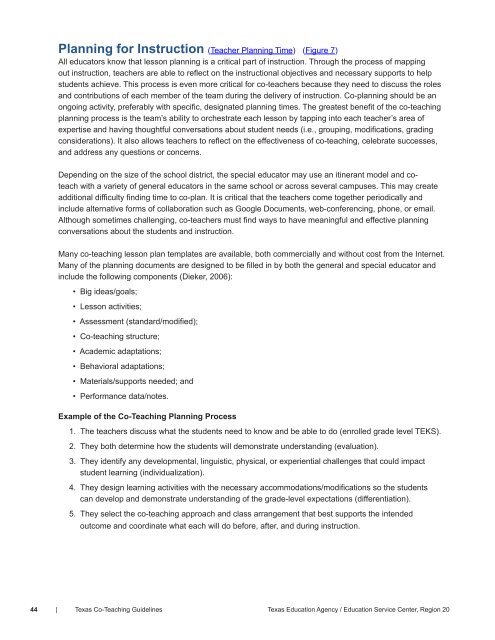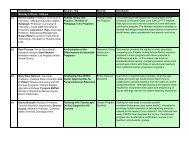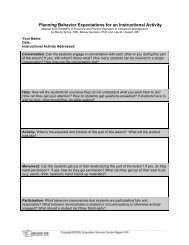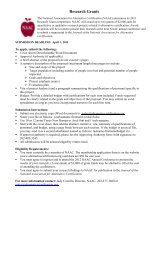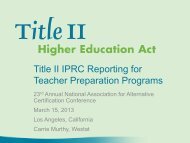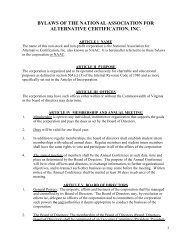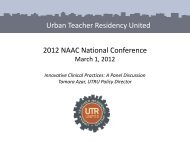Guidelines for Co-Teaching in Texas - Region 17
Guidelines for Co-Teaching in Texas - Region 17
Guidelines for Co-Teaching in Texas - Region 17
Create successful ePaper yourself
Turn your PDF publications into a flip-book with our unique Google optimized e-Paper software.
Plann<strong>in</strong>g <strong>for</strong> Instruction (Teacher Plann<strong>in</strong>g Time) (Figure 7)<br />
All educators know that lesson plann<strong>in</strong>g is a critical part of <strong>in</strong>struction. Through the process of mapp<strong>in</strong>g<br />
out <strong>in</strong>struction, teachers are able to reflect on the <strong>in</strong>structional objectives and necessary supports to help<br />
students achieve. This process is even more critical <strong>for</strong> co-teachers because they need to discuss the roles<br />
and contributions of each member of the team dur<strong>in</strong>g the delivery of <strong>in</strong>struction. <strong>Co</strong>-plann<strong>in</strong>g should be an<br />
ongo<strong>in</strong>g activity, preferably with specific, designated plann<strong>in</strong>g times. The greatest benefit of the co-teach<strong>in</strong>g<br />
plann<strong>in</strong>g process is the team’s ability to orchestrate each lesson by tapp<strong>in</strong>g <strong>in</strong>to each teacher’s area of<br />
expertise and hav<strong>in</strong>g thoughtful conversations about student needs (i.e., group<strong>in</strong>g, modifications, grad<strong>in</strong>g<br />
considerations). It also allows teachers to reflect on the effectiveness of co-teach<strong>in</strong>g, celebrate successes,<br />
and address any questions or concerns.<br />
Depend<strong>in</strong>g on the size of the school district, the special educator may use an it<strong>in</strong>erant model and coteach<br />
with a variety of general educators <strong>in</strong> the same school or across several campuses. This may create<br />
additional difficulty f<strong>in</strong>d<strong>in</strong>g time to co-plan. It is critical that the teachers come together periodically and<br />
<strong>in</strong>clude alternative <strong>for</strong>ms of collaboration such as Google Documents, web-conferenc<strong>in</strong>g, phone, or email.<br />
Although sometimes challeng<strong>in</strong>g, co-teachers must f<strong>in</strong>d ways to have mean<strong>in</strong>gful and effective plann<strong>in</strong>g<br />
conversations about the students and <strong>in</strong>struction.<br />
Many co-teach<strong>in</strong>g lesson plan templates are available, both commercially and without cost from the Internet.<br />
Many of the plann<strong>in</strong>g documents are designed to be filled <strong>in</strong> by both the general and special educator and<br />
<strong>in</strong>clude the follow<strong>in</strong>g components (Dieker, 2006):<br />
• Big ideas/goals;<br />
• Lesson activities;<br />
• Assessment (standard/modified);<br />
• <strong>Co</strong>-teach<strong>in</strong>g structure;<br />
• Academic adaptations;<br />
• Behavioral adaptations;<br />
• Materials/supports needed; and<br />
• Per<strong>for</strong>mance data/notes.<br />
Example of the <strong>Co</strong>-<strong>Teach<strong>in</strong>g</strong> Plann<strong>in</strong>g Process<br />
1. The teachers discuss what the students need to know and be able to do (enrolled grade level TEKS).<br />
2. They both determ<strong>in</strong>e how the students will demonstrate understand<strong>in</strong>g (evaluation).<br />
3. They identify any developmental, l<strong>in</strong>guistic, physical, or experiential challenges that could impact<br />
student learn<strong>in</strong>g (<strong>in</strong>dividualization).<br />
4. They design learn<strong>in</strong>g activities with the necessary accommodations/modifications so the students<br />
can develop and demonstrate understand<strong>in</strong>g of the grade-level expectations (differentiation).<br />
5. They select the co-teach<strong>in</strong>g approach and class arrangement that best supports the <strong>in</strong>tended<br />
outcome and coord<strong>in</strong>ate what each will do be<strong>for</strong>e, after, and dur<strong>in</strong>g <strong>in</strong>struction.<br />
44 | <strong>Texas</strong> <strong>Co</strong>-<strong>Teach<strong>in</strong>g</strong> <strong>Guidel<strong>in</strong>es</strong> <strong>Texas</strong> Education Agency / Education Service Center, <strong>Region</strong> 20


